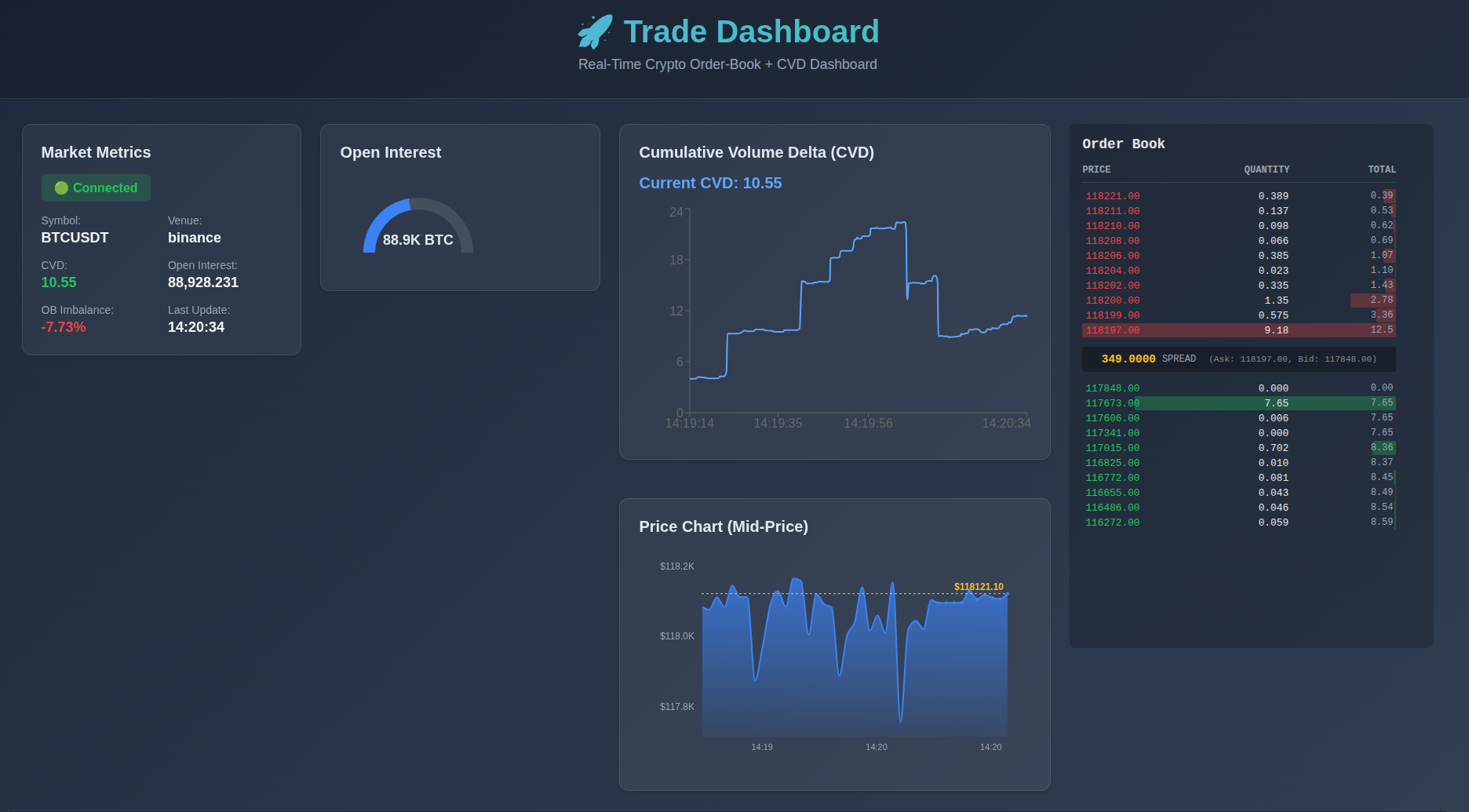Building a Real-Time Bitcoin Trading Dashboard in a Weekend: A Developer's Journey
Sometimes the best projects happen when you least expect them.
The Spark
It started like most weekend projects do – with a simple idea and way too much coffee. I wanted to build something that would give me real-time insights into cryptocurrency markets, something more than just checking prices on my phone. What I ended up with was a professional-grade trading dashboard that displays live order books, tracks cumulative volume delta, and monitors open interest – all updating in real-time.
But the journey to get there? That's where the real story lies.
The Weekend Sprint
Armed with nothing but enthusiasm and a vague idea of what I wanted to build, I dove headfirst into what was a quick weekend project. My weapon of choice? Windsurf IDE powered by Claude 4 – an AI coding assistant that promised to accelerate development.
The concept was fun but not super ambitious: a real-time crypto trading dashboard that would pull live data from Binance, display order book depth with heatmaps, track price movements, and calculate cumulative volume delta. And all built in a weekend.
The Reality Check
Here's what nobody tells you about AI-assisted development: it's incredibly powerful, but it's not magic.
I quickly found myself in what I like to call "credit burn mode" – making request after request to Claude 4, trying to iron out issues that seemed to multiply faster than I could fix them. The AI was brilliant at generating code, but some of the more nuanced problems required a human touch.
The biggest culprit? Linting errors.
You know those seemingly innocent warnings that pop up in your IDE? They became my weekend nemesis. Strange TypeScript errors that wouldn't disappear, ESLint complaints that made no sense, and configuration issues that had me questioning my life choices. Every fix seemed to introduce two new problems.
The Pivot
I started late Friday evening, and only spent an hour or so while tired and before frustration set in. I decided to try a different approach and switched to Gemini CLI (Google's 2.5 Pro model). The change of perspective helped – Gemini caught a few issues that Claude had missed and offered different solutions to the same problems.
But even with this tag-team approach, some stubborn issues remained. The kind that make you stare at your screen at 1 AM wondering if you should just start over.
The Sunday Morning Miracle
Sometimes you just need to sleep on it.
Sunday morning, I opened up Windsurf again with fresh eyes and a new cup of coffee. What happened next felt almost magical – those persistent linting errors that had consumed hours of my weekend? Fixed in minutes with just a few targeted requests to Claude.
It's funny how that works. The same AI that had me pulling my hair out the day before suddenly became laser-focused and efficient. Maybe it was my improved prompting, maybe it was luck, or maybe Sunday morning Claude is just different from Saturday night Claude.

What I Built
The end result exceeded my expectations. The dashboard features:
- Real-time order book visualization with color-coded depth charts
- Live price tracking updating every 2 seconds
- Cumulative Volume Delta (CVD) with historical charting
- Open interest monitoring with trend indicators
- Professional dark theme with glass effects and smooth animations
All of this connects to live Binance data streams with sub-500ms latency. It's the kind of tool I actually want to use, which is always the best measure of a successful side project.
Lessons Learned
AI coding assistants are powerful, but they're tools, not magic wands. They excel at generating boilerplate, implementing well-defined features, and offering alternative approaches. But they can also lead you down rabbit holes, especially when dealing with configuration and tooling issues.
Sometimes the best debugging happens away from the keyboard. That Sunday morning breakthrough wasn't just luck – it was the result of stepping back, getting some rest, and approaching the problems with a clearer mind.
Weekend projects don't have to be perfect. The goal isn't to build the next unicorn startup; it's to learn, experiment, and have fun. My trading dashboard isn't going to compete with professional platforms, but it taught me about WebSocket streams, real-time data visualization, and the patience required for AI-assisted development.
The Bigger Picture
This project represents something bigger than just a weekend coding session. It's a glimpse into the future of software development, where AI assistants can help us build complex applications in timeframes that would have been impossible just a few years ago.
Yes, I burned through a lot of AI credits. Yes, I got frustrated with linting errors. But I also built something genuinely useful in 48 hours that would have taken me weeks to complete on my own.
The tools are getting better, the AI models are getting smarter, and the barrier to building cool stuff keeps getting lower. That's pretty exciting.
Try It Yourself
If you're curious about the technical details or want to run the dashboard yourself, I've open-sourced the entire project. It's a monorepo with a Node.js backend and React frontend, complete with setup instructions and documentation.
The code isn't perfect – it's weekend project code – but it works, it's fast, and it solves a real problem. Sometimes that's all you need.
Want to see the dashboard in action? Check out the GitHub repository for setup instructions and live screenshots.
Have your own AI coding war stories? I'd love to hear them. The future of development is collaborative – human creativity plus AI capability – and we're all figuring it out together.